Key Takeaways
The global salon service market is projected to be USD 429.8 billion by 2035, with the rise in on-demand salon service requirements.
Core features include user authentication, salon discovery, real-time scheduling, payment integration, robust notifications, and reviews.
Steps to create a salon appointment booking app include market study, feature & tech stack selection, UI/UX design, phased development, secure payments, and testing.
Integrating AI enables intelligent scheduling, personalized suggestions, chatbot support, dynamic pricing, and automated marketing for the app.
Development cost of the salon app ranges from USD 10,000 to USD 80,000+, depending on features, design, platform, and AI integrations.
Monetization strategies include commissions, subscriptions, featured listings, in-app sales, and paid loyalty programs to generate revenue.
Partnering with experienced developers of JPLoft ensures a robust, feature-rich, and scalable app that supports future growth and user retention.
In this digitalized generation, one of the most impactful changes has been faced by the salon industry with the launch of salon appointment booking apps. If you are looking for ways to be part of this growing market, then knowing how to create a salon appointment booking app can be highly profitable for you.
These salon appointment booking apps allow clients to schedule services with just a few taps, while helping salon owners manage their business more efficiently. Steps to develop such apps start with market research, choosing features, designing UI, choosing tech stack, building in phases, testing, launching, and continuously updating for improvements.
From hairstyling and spa treatments to skincare and grooming, these apps offer a seamless way to book, reschedule, and pay for services online. For salon owners, the benefits go beyond convenience. They gain tools for staff management, real-time scheduling, customer relationship management, and even marketing automation.
In this guide, we will walk you through the essential steps, features, and strategies to build a salon appointment booking app that enhances customer satisfaction and improves business growth.
An Overview of Salon Appointment Booking Apps
A salon appointment booking app is a digital solution that allows customers to schedule beauty and wellness services directly from their smartphones. Instead of waiting for walk-ins, clients can browse services and confirm appointments with just a few taps on their mobile phone.
For salon owners, these apps act as a complete management tool. They help organize staff schedules, track appointments in real time, and reduce the chances of double-booking. Many apps also integrate with payment systems, allowing clients to pay in advance or at the salon, making transactions faster and more secure.
Modern salon booking apps offer attractive features such as automated reminders, loyalty programs, reviews, and personalized recommendations. Some even use AI and analytics to suggest services, forecast demand, and optimize staff allocation.
As customer expectations shift toward digital-first experiences, having the right understanding of how to create a salon appointment booking app will help you stay in the competition and grow.
Salon Appointment Booking Apps and Related Market Stats
The global salon app and services market is experiencing rapid growth in 2025, driven by evolving wellness trends and increased consumer demand.
-
The global salon services market is valued at USD 232.6 billion in 2025 and is projected to reach USD 429.8 billion by 2035, reflecting a CAGR of 6.5%, according to FutureMarketInsights.
-
According to FortuneBusinessInsights, North America holds the largest market share in salon apps/software, with Europe holding the second largest share in the market.
-
The salon software market size reached about USD 1.01 billion in 2025, expected to hit USD 1.69 billion by 2030 at a CAGR of 10.9%, as estimated by MordorIntelligence.
-
In a local survey in the US, it was found that 78% of millennials now prefer booking beauty services through mobile apps.
Creating salon app in the 2025 market is defined by technological innovation, rapid digital transformation, and a strong focus on wellness and personalized experiences. Making this digital platform central to business competitiveness and customer retention.
Now that we’ve explored what these apps are and why they matter, let’s take a closer look at how they actually work behind the scenes.
How does a Salon Appointment Booking App work?
A salon appointment booking app is designed to simplify the process of booking, managing, and delivering salon services for both clients and salon owners. Here is a step-by-step breakdown of the workflow of the salon appointment booking app:
Step 1: User Registration and Profile Setup
Clients start by downloading the app and creating a profile. They can add basic details such as name, contact information, and preferences. Some apps also allow linking payment methods and loyalty accounts for a smoother experience.
Step 2: Service Browsing and Selection
Once registered, users can browse the salon’s list of services, such as haircuts, spa treatments, skincare, or grooming. Each service is usually accompanied by details like duration, price, and available staff members.
Step 3: Real-Time Availability and Scheduling
The app displays available time slots based on staff schedules and salon operating hours. Clients can pick their preferred date, time, and stylist or technician. Real-time updates prevent double bookings.
Step 4: Booking Confirmation and Notifications
After selecting a service, clients confirm the booking with a single tap. They receive instant confirmation via in-app notification, SMS, or email. Automated reminders before the appointment reduce no-shows.
Step 5: Secure Payments and Offers
Many salon booking apps integrate payment gateways, allowing users to pay in advance or choose to pay at the salon. Clients can also apply discounts, membership credits, or promotional offers seamlessly.
Step 6: Salon Dashboard for Staff
On the business side, salon staff and managers access a dashboard to view upcoming appointments, manage staff schedules, and track customer preferences. This improves time management and reduces administrative workload.
Step 7: Feedback and Reviews
After the appointment, clients can rate their experience and leave reviews. This helps salons improve service quality and build credibility. Positive feedback also acts as social proof, attracting new customers to the salon.
If you build a salon appointment booking app, it acts as a bridge between customers and salons. Offering convenience, efficiency, and better customer experiences while helping businesses streamline their operations.
Understanding how a salon appointment booking app functions gives us insight into its practical value. The next step is to explore why it’s worth creating one in the first place and how it can benefit both salon owners and clients.
Why Create a Salon Appointment Booking App?
Nowadays, customers demand convenience, speed, and personalized experiences. Due to these reasons businesses need a salon app to remain competitive in the market.
1. Convenience for Clients
An app allows customers to book their appointments anytime, anywhere, without needing to call the salon. This 24/7 availability improves customer satisfaction and reduces dependency on manual booking.
2. Better Time and Staff Management
Salon owners and managers can view real-time bookings, assign tasks, and manage staff schedules effortlessly. This minimizes scheduling conflicts and ensures efficient use of resources.
3. Reduced No-Shows and Cancellations
Automated reminders and notifications help reduce no-shows by keeping clients updated about upcoming appointments. Rescheduling can also be managed directly through the app, saving time for both customers and staff.
4. Boost in Customer Loyalty
With features like reward points, exclusive offers, and personalized recommendations, the app helps salons build stronger relationships with clients. Loyal customers are more likely to return and refer others.
5. Increased Revenue Opportunities
Apps can promote additional services, offer package deals, and upsell treatments during the booking process. This creates more opportunities for generating higher revenue per customer.
Knowing the proper steps of how to make a salon appointment booking app enhances efficiency, strengthens customer engagement, and drives long-term business growth. Making it an essential investment for every salon owner.
Knowing why salon appointment booking app development is a smart investment sets the stage for the next step. That is, identifying the key features that will make it effective, user-friendly, and truly valuable for both clients and salon owners.
Must-Have Features to Build a Salon Appointment Booking App
While you develop a salon appointment booking app, it involves a wide range of features to ensure a smooth experience for both customers and salon staff. Here we have listed the best salon app features:
|
Components |
Features |
|
User Authentication and Profile Management |
|
|
Salon and Service Discovery |
|
|
Real-Time Appointment Booking |
|
|
Payment Integration |
|
|
Notifications and Reminders |
|
|
Ratings & Reviews |
|
|
Admin Panel for Salons |
|
|
Customer Support |
|
|
Salon Promotions & Marketing |
|
|
Analytics & Reports |
|
A well-designed salon booking app combines convenience, efficiency, and seamless payment integration to enhance the experience for both customers and salons. Prioritizing user-friendly features and reliability ensures long-term success and customer satisfaction. Hire the best mobile app development company to get these features seamlessly integrated into your app.
After outlining the essential features that make a salon appointment booking app successful. The next step is to understand how to actually bring those features to life by creating the app from the ground up.
How to Create a Salon Appointment Booking App?
A guide to create a salon appointment booking app with the right approach can help you design a solution that is simple, effective, and user-friendly. Whether you are a salon owner or an entrepreneur, following a clear process to make a salon appointment booking app can help you bring your idea to life:
Step 1: Research the Market and Define Your Goals
-
Study popular salon booking apps developed like Booksy to see what features they offer and where they fall short.
-
Understand your target audience. Are you building for salon owners, customers, or both?
-
Define your unique value proposition. What makes your salon app idea different from other apps in the market?
-
Set clear goals like improving convenience, reducing no-shows, or increasing customer loyalty.
Step 2: Decide the Core Features
-
For Users: User registration with multiple sign-in options, service selections, appointment scheduling, securing in-app payments, booking status alerts, reviews, and personalized dashboards.
-
For Professionals: Simple onboarding with verification, profile management, services offered, portfolio, pricing, availability calendar, job notifications, and tracking of earnings.
-
For Admins: Control panel to oversee users/service providers, manage content, monitor transactions, run analytics, and handle disputes.
Step 3: Choose the Right Tech Stack
-
Choose the salon app tech stack that is most convenient for your business model.
-
Mobile Development: Swift for iOS, Kotlin for Android, and React Native or Flutter for cross-platform and fast launches.
-
Backend & Database: Plan the server and business logic, use Node.js/Django/Spring Boot for APIs, and use PostgreSQL/MySQL/MongoDB for the user data database.
-
APIs & Integration: Integrate third-party services for maps, Stripe/PayPal for secure payments, email/SMS notifications, and authentication.
-
Real-Time Features: Use sockets for live chat and real-time booking updates.
-
Cloud Selection: For cloud services, deploy on AWS, Google Cloud, or Azure for scalability.
-
Geolocation & Maps: Integrate geo-tracking with Google Maps or Mapbox.
Step 4: Design a User-Friendly Interface (UI/UX)
-
Keep the salon app design simple, elegant, and aligned with the beauty industry’s aesthetics.
-
Ensure the booking flow takes only a couple of steps.
-
Use clean navigation, attractive icons, and calming color themes.
-
Prioritize responsiveness for different screen sizes of the mobile app design.
Step 5: Develop the App in Phases
-
Phase 1, MVP (Minimum Viable Product): Build the basic app with core features to test the idea.
-
Phase 2, Beta Testing: Share the app with a small group of users, gather feedback, and fix issues.
-
Phase 3, Full Launch: Add advanced features, refine the design, and release to app stores.
-
This approach saves costs and ensures you build based on real user feedback.
Step 6: Integrate Secure Payment Options
-
Just like the top best salon apps of the industry, they offer multiple payment methods like credit/debit cards, wallets, UPI, and PayPal.
-
Use secure payment gateways with encryption to protect user data.
-
Provide both prepayment and pay-at-salon options to improve flexibility.
Step 7: Add Notifications and Reminders
-
Automate booking confirmations, reminders, and promotional alerts.
-
Send notifications through in-app messages, SMS, or emails.
-
Personalized reminders reduce no-shows and improve customer experience.
Step 8: Include a Salon Dashboard for Owners/Staff
-
Let salon owners view all bookings in real time.
-
Allow staff to manage schedules, assign services, and track availability.
-
Provide analytics on peak hours, most popular services, and repeat customers.
-
A dashboard simplifies salon operations and improves efficiency.
Step 9: Test the App Thoroughly
-
Conduct functional testing to check if all features work as expected.
-
Test payment flow, speed, and app stability under load.
-
Run device compatibility tests across Android and iOS versions.
-
Involve real salon customers in salon app testing to gather practical feedback.
Step 10: Launch the App
-
Publish the app on the Google Play Store and Apple App Store.
-
Optimize app store descriptions with keywords for visibility.
-
Promote through social media, local salons, and digital marketing campaigns.
-
Offer introductory discounts or referral bonuses to encourage downloads.
Step 11: Gather Feedback and Improve
-
Monitor user reviews, ratings, and feedback regularly.
-
Update the app based on customer suggestions.
-
Add advanced features like loyalty programs, AI-based offers, or stylist recommendations.
-
Constant improvements ensure higher customer satisfaction and engagement.
Step 12: Maintain and Scale the App
-
Provide regular updates to fix bugs, improve speed, and enhance features.
-
Ensure strong salon app security practices to maintain trust.
-
Scale the app as the business grows by adding support for multiple salons, multi-language options, or e-commerce for beauty products.
-
Long-term salon app maintenance keeps the app competitive.
By following these steps on how to create a salon appointment booking app, you can build an app that simplifies salon management and enhances customer satisfaction. With the right approach, your app can become a powerful tool for boosting efficiency, increasing revenue, and creating a loyal customer base. Start a salon business small, listen to your customer requirements, and scale as your app grows.
Once you understand the process of how to develop an AI salon appointment booking app, the next step is to see how AI can enhance its development. Making the app smarter, more efficient, and tailored to both salon business needs and customer expectations.
How AI Helps in Salon Appointment Booking App Development?
By integrating AI in salon apps, they go beyond simple scheduling to deliver personalized, efficient, and intelligent solutions for both salon owners and clients. Below we have listed the benefits to build an AI salon appointment booking app:
1] Smart Scheduling and Automation
AI-powered algorithms can analyze booking patterns, staff availability, and service durations to automatically suggest the best appointment slots. This reduces scheduling conflicts, optimizes staff utilization, and ensures clients get convenient options without manual effort.
2] Personalized Recommendations
Create an AI app where AI uses customer history and preferences to recommend services, stylists, or special packages. For example, if a client frequently books hair treatments, the app can suggest new hair spa offers or seasonal discounts tailored to their interests.
3] Intelligent Chatbots and Virtual Assistants
AI-powered chatbots provide 24/7 customer support by answering FAQs, helping with bookings, sending reminders, and even rescheduling appointments. This not only improves customer experience but also reduces the workload of front-desk staff.
4] Dynamic Pricing and Discounts
AI can analyze customer behavior and top salon app trends in the market to recommend the best pricing strategies. For instance, it can offer discounts during non-peak hours to attract more bookings, boosting overall salon revenue.
5] Automated Marketing Campaigns
AI enables personalized marketing by segmenting clients based on behavior and preferences. Salons can send targeted promotions, push notifications, or loyalty rewards, increasing customer retention and engagement.
AI integration with the help of AI app development service providers in salon appointment booking apps improves efficiency and convenience. It transforms the salon booking apps into intelligent platforms that enhance customer satisfaction, streamline operations, and boost business growth.
Now that we've explored how AI can transform the development and functionality of a salon appointment booking app, it's important to consider the costs involved in bringing this innovative solution to life.
Cost to Create a Salon Appointment Booking App
The cost to make a salon appointment booking app ranges between USD 10,000 to USD 80,000+. This development cost depends on several factors, like features, platform choice, design complexity, and the development team’s location.
Let's now see how much does it cost to develop a salon appointment booking app:
|
App Component |
Estimated Cost (in USD) |
|
User Registration & Profile |
$1,000 – $4,000 |
|
Service Browsing & Selection |
$1,000 – $5,000 |
|
Appointment Scheduling |
$1,500 – $7,000 |
|
Payment Integration |
$1,000 – $5,000 |
|
Notifications & Reminders |
$500 – $3,000 |
|
Staff/Salon Dashboard |
$1,000 – $6,000 |
|
Reviews & Feedback |
$500 – $3,000 |
|
Loyalty Programs/Membership |
$2,500 – $5,000 |
|
AI Features / Personalized Offers |
$3,000 – $6,000 |
|
Advanced Analytics / Reporting |
$3,000 – $6,000 |
|
UI/UX Design & Branding |
$1,000 – $6,000 |
|
Testing & QA |
$500 – $4,000 |
|
Maintenance & Updates (Annual) |
$1,000 – $6,000 |
App Complexity with Estimated Cost to Build an Apple Music Clone:
Below, we have provided the estimated cost to build a salon app based on the complexity of the app:
A] Basic MVP:
-
Features: simple features, one platform
-
Estimated Cost in USD: $10,000 – $20,000
B] Mid-Level App:
-
Features: All Basic features + advanced features, multi-platform
-
Estimated Cost in USD: $20,000 – $40,000
C] Advanced App:
-
Features: AI features, loyalty programs, analytics, and premium design
-
Estimated Cost in USD: $40,000 – $80,000+
Knowing the cost to build a salon appointment booking app helps salon owners and entrepreneurs plan their budget effectively. Investing in a high-quality salon booking app ensures better user experience, high customer retention, and long-term revenue growth. Hiring an on-demand app development company can help you get the best results from your investment.
After understanding the costs involved in developing a salon appointment booking app, the next crucial step is exploring how you can monetize it to ensure long-term growth and profitability.
How to Monetize a Salon Appointment Booking App?
If you create a custom salon appointment booking app, it will not just work for convenience but also be a smart way to generate revenue. With the growing demand for digital solutions in the beauty and wellness industry, monetization strategies can turn your app into a profitable business model.
Here are the most effective ways to monetize a salon app:
► Commission-Based Model
One of the most popular approaches is charging a small commission on every booking made through the app. For instance, salons can pay a percentage of each confirmed appointment, ensuring a steady income for the app owner.
► Subscription Plans for Salons
Offer salons different subscription packages (monthly, quarterly, or yearly) with tiered features. Basic plans can include appointment scheduling, while premium plans may provide advanced features like staff management, analytics, or loyalty programs.
► Featured Listings and Promotions
Salons can pay to get featured on the app’s homepage or in top search results, gaining higher visibility among potential customers. This boosts their bookings while generating ad revenue for the app owner.
► In-App Product Sales
The app can integrate e-commerce functionality, allowing salons to sell beauty products, skincare kits, or accessories directly to customers. A small profit margin or commission on each sale adds another revenue stream.
► Loyalty and Membership Programs
Introduce paid membership options where clients can unlock exclusive deals, priority bookings, or discounts. This enhances customer retention while creating recurring income.
By combining these monetization strategies, you create a salon appointment booking app that can serve as both a business enabler for salons and a profitable venture for businesses. The key is to balance user experience with monetization, ensuring that revenue models do not compromise client experience.
In the next step, we will look at development practices that can significantly improve the overall quality, performance, and success of your salon appointment booking app.
Practices to Enhance the Salon Appointment Booking App Development
Design your salon appointment booking app as a solution that ensures convenience, efficiency, and a seamless experience for both the customers and salon owners. To achieve this, you should follow best practices of how to develop a salon appointment booking app that enhances usability, functionality, and performance:
1] Focus on User-Centric Design
Create a mobile app with a clean, intuitive, and visually appealing interface. A simple booking flow, minimal clicks, and clear navigation encourage users to complete appointments without confusion.
2] Implement Real-Time Scheduling
Real-time updates prevent double-booking and ensure that availability is always accurate. Synchronizing staff schedules and salon operating hours keeps both clients and staff informed.
3] Ensure Seamless Payment Integration
Multiple payment options, such as credit/debit cards, digital wallets, and UPI, make the booking process hassle-free. Adding secure gateways with encryption builds trust among users.
4] Add Personalization Features
Clients appreciate tailored experiences. Using data from past appointments, apps can suggest preferred stylists, services, or exclusive offers, improving customer satisfaction and retention.
5] Regular Updates and Scalability
To stay competitive, apps should be updated with new features, bug fixes, and performance upgrades. Building with scalability in mind ensures the app grows with the business.
By following these practices to create a salon appointment booking app, you can provide seamless booking experiences to customers, gain stronger customer loyalty, and achieve long-term business success.
Work with JPLoft to Bring Your Salon Appointment Booking App Idea to Life
Planning to build an AI Salon Appointment Booking App and turn your idea into a reality? This will require expertise, creativity, and cutting-edge technology, and JPloft has got your back in this!
At JPLoft, we specialize in building robust, user-friendly, and scalable mobile applications that cater to the unique needs of the beauty and wellness industry. Our team of experienced developers, designers, and business strategists works closely with you to understand your vision and translate it into an app that delights customers and empowers salon owners.
From intuitive booking flows and secure payment gateways to AI-driven personalization and analytics, we ensure every feature enhances user experience and boosts business efficiency. JPLoft, a salon app development company, leverages the latest technologies and best development practices to help you launch an app that stands out in a competitive market.
Let us help you transform your idea into a powerful, revenue-generating app that elevates customer satisfaction and drives growth.
Conclusion
The beauty and wellness industry is evolving rapidly, and digital solutions like salon appointment booking apps are becoming essential for both clients and salon owners. These apps not only streamline booking and payment processes. Knowing how to develop a salon appointment booking app can help you enhance customer engagement, improve staff management, and provide valuable insights for business growth.
By incorporating features such as real-time booking, automated reminders, AI-driven personalization, and loyalty programs, salons can deliver a seamless and personalized experience. Moreover, the right development approach, combined with strategic monetization models, ensures that your app is a great convenience tool and is also a profitable business asset.
Whether you are a salon owner looking to modernize operations or an entrepreneur exploring potential in the beauty industry, following the guide to create a salon appointment booking app can be your best move. Giving efficiency, customer satisfaction, and becoming a long-term revenue source. The future of salon services is digital, and now is the perfect time to invest in one.
FAQs
To create a salon appointment booking app, start with market research and define core features like scheduling, payments, and notifications. Design a user-friendly interface, choose the right tech stack, and develop in phases. Test thoroughly, launch on app stores, gather feedback, and continuously update to improve performance and customer experience.
The cost ranges from USD 10,000 to USD 80,000+, depending on complexity, features, design, and platforms (iOS, Android, or cross-platform). Basic apps are more affordable, while advanced apps with AI, loyalty programs, and analytics require higher investment.
Key features include user registration, service browsing, appointment scheduling, real-time availability, payment integration, reminders, reviews, and salon dashboards. Advanced features like AI suggestions, loyalty programs, and analytics can be added later for better engagement.
On average, development takes 3 to 6 months, depending on the app’s complexity. A basic app may be built faster, while apps with advanced features, custom design, and integrations may take longer.
Yes. AI enables smart scheduling, personalized service recommendations, predictive analytics, automated marketing, and even chatbots for 24/7 support. These features enhance customer experience, improve efficiency, and increase revenue opportunities for salons.





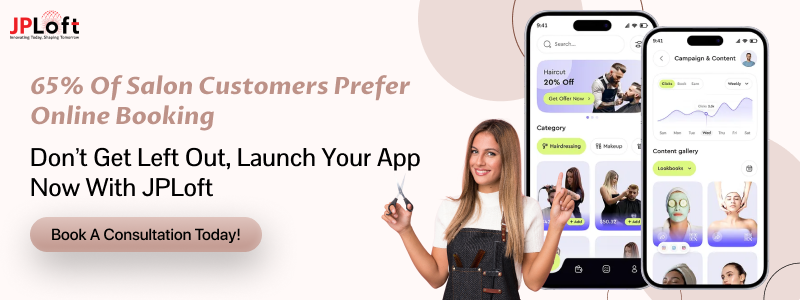
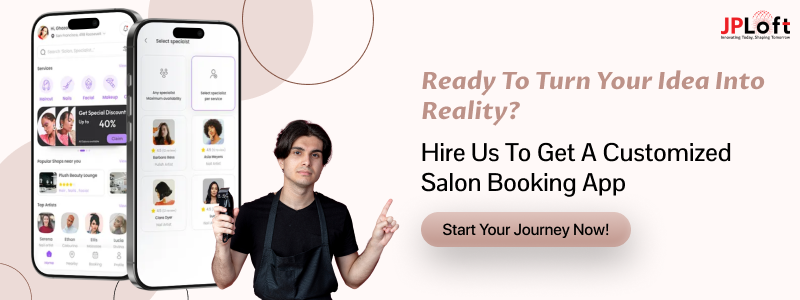

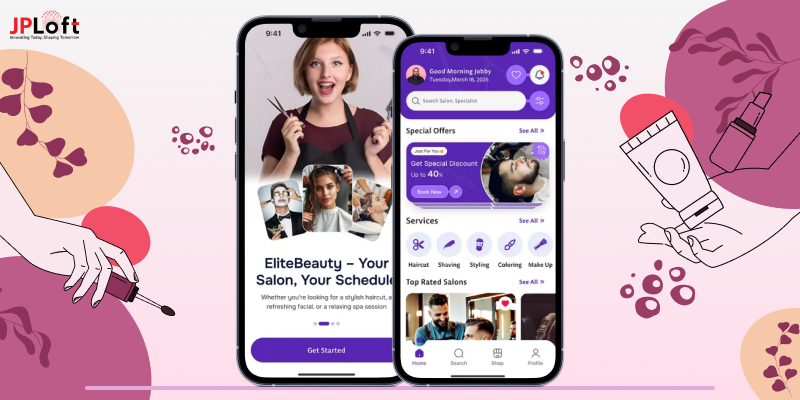
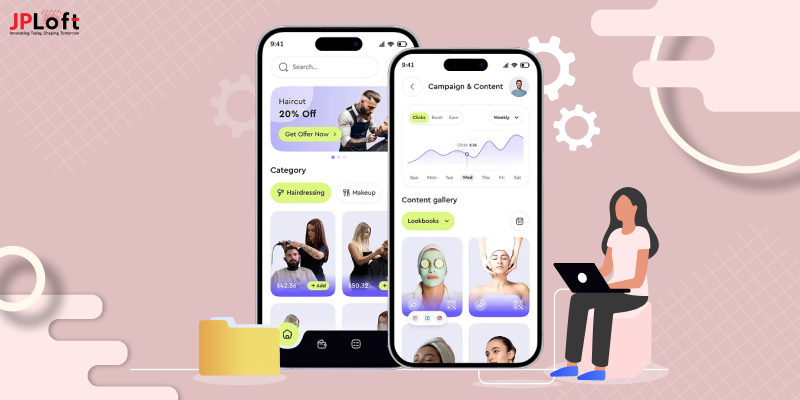
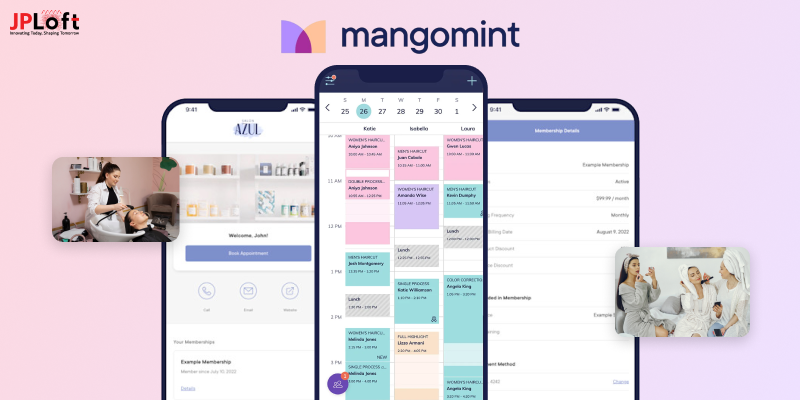


Share this blog